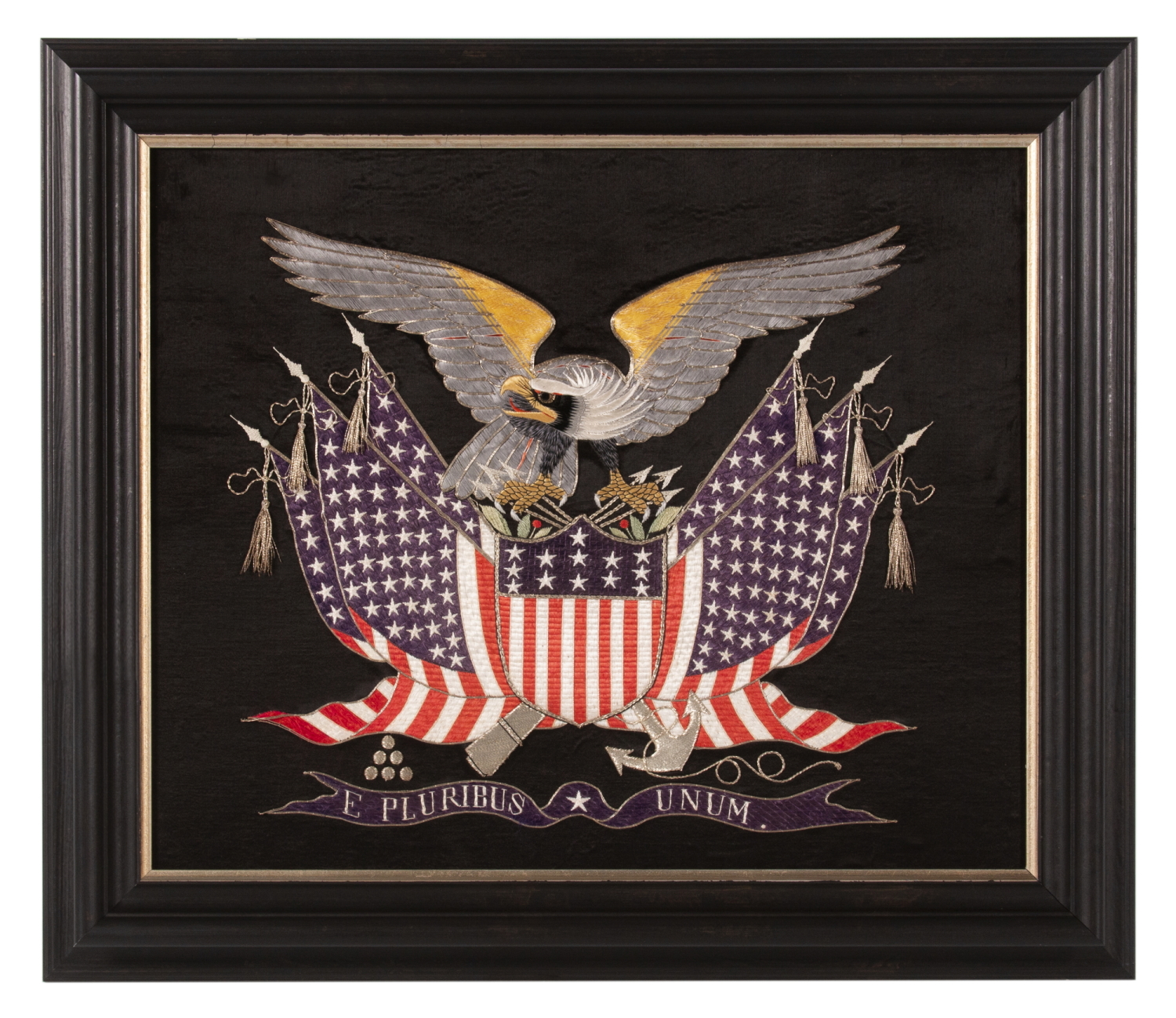
| |
ELABORATE SAILOR’S SOUVENIR EMBROIDERY FROM THE ORIENT WITH A LARGE FEDERAL EAGLE, CROSSED FLAGS, CANNON AND ANCHOR, CA 1896-1907 |
|
| Available: |
Sold |
| Frame Size (H x L): |
26.5" x 30.75" |
| Flag Size (H x L): |
20" x 24.25" |
|
| Description....: |
|
Between roughly 1885 and 1915, American sailors visiting the orient could obtain beautiful needlework embroideries on shore, with patriotic American themes. These extraordinary works of art were acquired as mementos of a long voyage, often with the hope that they might be presented as gifts for loved ones and friends.
Using silk floss, elaborately embellished with both silver and gold metallic bullion thread, and combining various types of embroidery work and stitchery, artists working the piers in port towns would create these elaborate pictures, customizing them to the buyer's content. Executed on silk, like this example, or sometimes on velvet, the most common devices included eagles, flags, and shields, often with various maritime elements.
This particular example features a spread-winged, war-like eagle, posed here upon clusters of arrows emerging from the apex of a federal shield, flanked on either side by trios of American national flags. Laurel leaves spring from the top of the shield, while a cannon barrel and an anchor extend from the base, with a stack of cannon balls to the left and a billowing streamer below. The familiar "E Pluribus Unum" motto appears on the streamer, separated by a single star, interestingly symbolic of the Latin phrase, which means "out of many, one."
It is of interest to note that the count of 45 stars on each flag in the foreground is correct for the period, as well as the count of 13 stars and 13 pales (vertical stripes) on the shield. The attention to detail is relatively amazing, especially given the point of origin. The colors of the pales are reversed, but few are aware of their appropriate positioning on a shield. It was not uncommon for American-made patriotic objects to lack such detail.
Utah became the 45th state in 1896. It had been attempting to gain statehood for many years, but remained a territory, primarily due to the fact that the Mormon Church and Utah authorities continued to be openly tolerant of polygamy. In 1890, Mormon Church President Wilford Woodruff published a manifesto that denounced the contract of “any marriages forbidden by the law of the land”. This gave way to Utah’s 1896 acceptance. The 45 star flag was generally used from that year until 1907, when Oklahoma joined the Union. Due to the Spanish-American War (1898) and Roosevelt’s famous world tour of the “White Fleet” (1907-1909), this was an extremely patriotic period.
When examining the level of craftsmanship, note the glass eye employed in the eagle and the tassels, carefully knotted from metallic bullion thread. Also note the treatment of the raised feathers on the legs, the scales on the talons, and the spiraling chain of the anchor. I have seen many of these embroideries, and while the mix of images here is not unusual, the attractive way in which they are sewn and displayed is excellent, as are the colors. The yellow in the wings is especially eye-catching.
Mounting: The textile was framed in our own conservation department. The black-painted and gilded molding is Italian, with a traditional American profile. The glazing is U.V. protective plexiglas.
Condition: There are minor issues in the silk background, but the overall condition is excellent. |
|
|
|
| Collector Level: |
Intermediate-Level Collectors and Special Gifts |
|
| Flag Type: |
|
|
| Star Count: |
45 |
|
| Earliest Date of Origin: |
1896 |
|
| Latest Date of Origin: |
1907 |
|
| State/Affiliation: |
Utah |
|
| War Association: |
|
|
| Price: |
SOLD |
|
| |
Views: 1382 |
|
|
|

